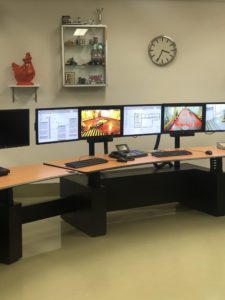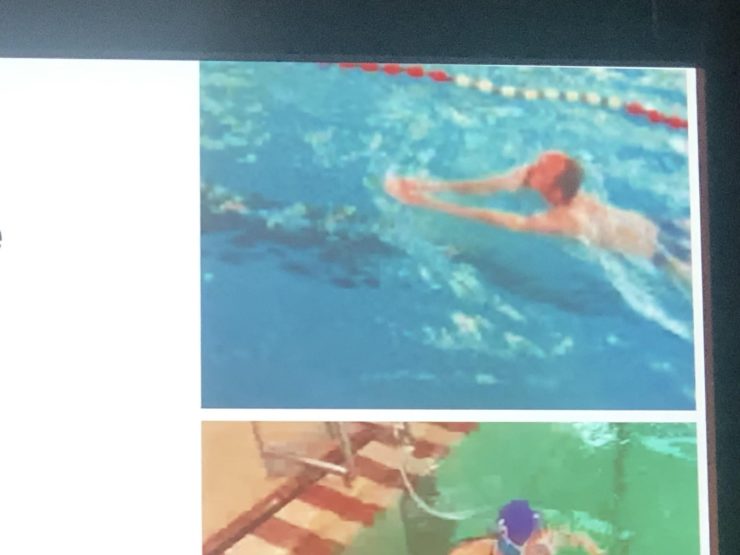Seminar Blogs
“Loud tools” – Freya Kir
This writing is the third part in a series covering different methods on current perspectives for measuring transmissions in motions. The writings specifically draw on references and inspiration shared from the seminar of the same title hosted by the University of Utrecht during the first half of 2020. Throughout the written reflections the intention is set to unpack approaches for measuring tools, instruments and imagination as bridges between unconventional and scientific methods. Following a Horizon of beats as measuring tools, and Infrastructure of theatrical tools this part dives into the past, current, and present traces of sonification.
Somewhere in the future:

Covra, Nuclear waste processing and storage centre, Vlissingen, Netherlands, 09.10.2019, photo by Freja Kir
Smooth light and long shadows arise from the red dawn of a new rising sun. The growing light uncover the contours of a simple cityscape. In the foreground beams of light reveal a grey decay of rusty constructions, broken glass, and bleached walls. Warm winds breath through empty skyscrapers, leaving sounds of hollow echos behind. Interior of various scales is left scattered around. Now: imagine an alien species inspecting this unfolding scenery and with careful contemplation investigating these forgotten human remains – infiltrated cables, stacks of screens, and piles of computers.
If the purpose of a media object cannot be displaced from its original meditation, (McLuhan, 1964) then these most common everyday technological tools may come to reflect the imagined human species as a one-eyed creature, wearing no ears and surely without legs too.
Body as a sound machine
After drawing up a similar alien metaphor, Dr. Thomas Hermann (Bielefeld University) introduced his lecture on “Sonification for Sharing Auditory Perspectives on Data ”. In this line of consideration, sonification is presented as a track of auditory methods to convey and produce alternative scientific contributions to visualized data. With examples of sonification ranging from mathematics education for the blind, or relation between body, movement, and water in swimming courses, the field of sonification unfolds and uncountable direction of methods. As pointed to by Hermann, the human capability of hearing is 24/7 active and regardless of context arrives to us from 360 degrees. Thereby, a study into sonification also comes to reflect how for instance the interface of the computer lacks aspects of human nature and comes to neglect other senses.

Swimming exercise with sound measurement. Slide from lecture by dr. Thomas Hermann, captured 19.02.2020, Utrecht University, photo by Freja Kir
A walk through the forest
When walking through the forest our experience takes form through sounds, smells, and the freshness of the wind. Sound, smell, touch are opposed components to classical visual digital data observation. In the context of current perspectives for measuring transmissions in motions, these everyday aspects of sensing are interesting to hold on to for a moment.
In any given environment the cognitive ability of humankind to understand rhythms and recognize patterns is part of connecting content together. Through this process even fragmented matter is transformed into coherent information (Drucker, 2011). Though sonification as a methodology draws on hearing as a means for learning, other methods should naturally not be discarded. Rather, looking to sonification as an interdisciplinary research field allows us to consider how it may unfold together with different skills. Learning how to bridge data with sound demands a key requirement of learning to listen. What you hear when you start listening is naturally subjective and never universal. But adding sonification to the learning process has the potential of producing various access to data through the sound of unconventional methods.
References:
- Drucker, J., Humanities Approaches to Interface Theory, In Culture Machine, Vol 12, 2011
- McLuhan, M., Understanding Media The extensions of man, McGraw-Hill, 1964
Images:
- Covra, Nuclear waste processing and storage centre, Vlissingen, Netherlands, 09.10.2019, photo by Freja Kir
- Swimming exercise with sound measurement. Slide from lecture by dr. Thomas Hermann, captured 19.02.2020, Utrecht University, photo by Freja Kir

